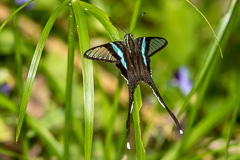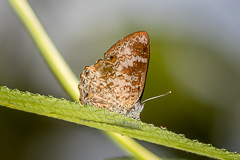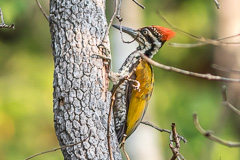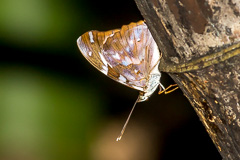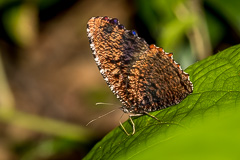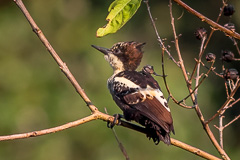Overview
Dates: |
5 - 10 Nov 2019. |
With Steve Tibbett. This, our third trip to Umphang, followed visits in 2012 and 2015. These previous trips had concentrated on birds - specifically Burmese Yuhina and Yellow-vented Warbler respectively. However, this trip was aimed primarily at western butterfly species but, as usual, we were frequently side-tracked by birds, reptiles, mammals, amphibians, dragonflies and insects.
We also intended to search for, and explore, new localities south and west of Umphang, which we'd not had the opportunity to do previously due to time constraints. As driving times to Umphang are excessive, this area is almost never visited by birders or naturalists. As the nearby Thi Lo Su Waterfall, is the largest in Thailand, November is the most popular time with general tourists, when water volumes are greatest, following the wet season. Indeed the falls are impressive.
5 Nov. We left Chiang Mai early, arriving Lan Sang around 11:00. Spent a couple of hours at the waterfalls near the headquarters and the Nature Trail that runs along the river to the campsite. Extremely little in the bird line, but a few puddles of butterflies at the falls contained Studded Sergeant, Cycad Blue and Green Dragontail. We had half-hoped for Siam Babul Blue which has been here in the past, but no luck. With time running we moved the 20 kilometres farther along the highway to Thaksin Maharat. Although we tried, we failed to convince the staff at the entrance that we could use the ticket from Lan Sang for entry; but worth a try. Best finds of the short afternoon were Common Green Magpie and Chocolate Grass Yellow. Continued to Mae Sot where we spent the night. 6 Nov. A two and half hour drive on twisting mountain roads, toward Umphang, brought us as far as the best upper elevation forest accessible along the road crossing the sanctuary. A surprising number of heavy agricultural trucks also plough this route, so care is needed when driving. Despite good weather, few butterflies were active; always a risk at this time of year when the weather cools at altitude. Several White-throated Bulbul were calling in the vicinity, as well as Maroon Oriole, Pygmy Cupwing, Golden-throated Barbet and Northern White-crowned Forktail. Deciding that it would be more profitable at lower altitudes, we tried a few kilometres farther downhill where, in the past, we'd found Burmese Yuhina. No luck today, but we did unexpectedly find Karen Gem, and on dropping more, an excellent Common Onyx. On arrival at Umphang, as we had an hour to spare, we headed to Thi Lo Cho Waterfall using the satnav. Unfortunately, as with numerous locations we'd previously attempted to locate using the official Thai satnav data, we ended up in the middle of a forest track with no sign of a waterfall or even a river. A short walk here produced Banded Bay Cuckoo, Greater Flameback and Greater Yellownape. Overnight in Umphang which, although in no way can be considered a culinary hot spot, we found a good green curry and cold beer. 7 Nov. The whole day exploring for access and habitat along the road running southward from Umphang toward Thung Yai Naresuan Wildlife Sanctuary. Results were mixed. Our first stop, at the Doi Hua Mot viewpoint was disappointing, as the viewpoint itself is mostly dry and open. The adjacent forest looked better but held nothing of interest, other than a calling Square-tailed Drongo-Cuckoo, and after an hour we pressed on. According to the satnav, another waterfall, Thi Lo Re, was about ten kilometres to the south, so we tried that. Once again the satnav data proved incorrect, with the turn off totally non-existent. Nearby we found a rough track, seemingly going in the correct direction, so decided to follow on foot. This track was excellent for butterflies, with both Banded Dandy and Great Marquis. Unfortunately, after a couple of kilometres the track was heading in the wrong direction so we back-tracked and drove south once more. After a short distance we crossed a river near one of the ranger stations and walked a short track adjacent to the river, finding Blue-eared Kingfisher, White Diadem and Yellow Pasha. Late in the day we attempted to find Palatha Forest Park which, despite being five kilometres off road, was actually signposted and found without effort. A very pleasant, small, park with a good waterfall. Evidently only one or two visitors per year here due to it being off road, and no staff were present. Being in a deep valley and late afternoon, it was shady so not so good for butterflies, but surely we will revisit this site on a future trip. 8 Nov. All day spent along the road and trail to Thi Lo Su Waterfall. The 24 kilometre drive from the entrance to the campsite and head of the trail to the falls was in the process of being concreted, with some heavy trucks and dust in places. Until recently, it was mandatory to use a local driver to access the falls, an unpopular tactic that limited visitor numbers. Now, such a restriction has been removed so that using one's own vehicle is possible, enabling birding and exploration en route. However, as no trails are available, only roadside birding is really possible. We found Heart-spotted Woodpecker and Violet Cuckoo, as well as Pale-legged Leaf Warbler common by voice. Once at the campsite it's a one and a half kilometre walk to the falls. We found the trail in excellent condition, mostly along a raised concrete walkway and passing through excellent forest. A number of interesting butterflies were found including Dried-leaf Palmfly and Western Kaiser. The falls themselves are definitely worth the walk. On the drive out we found a good butterfly puddling area containing three rajah species - Malayan Rajah, Common Tawny Rajah and Scarce Tawny Rajah - among a larger collection of interest. 9 Nov. We started the day with an early return to the river we'd found two days earlier. However, as it was still early in the day, butterfly activity was minimal, so we headed back toward Umphang, stopping at a couple of sites we'd found on the way in. Again, the highest levels were rather quiet, though a longer stop on the way up found Red Imperial and Common Cornelian. Mid afternoon we headed to Mae Sot. 10 Nov. The morning spent at Thaksin Maharat, with a pair of Kalij Pheasant seen well. In sunny spots we encountered a good range of butterflies including, Painted Lady, Felder's Linebue, White-edged Blue Baron and Streaked Baron. Shortly after midday we headed back to Chiang Mai to celebrate a successful trip with dinner and a few more cold beers. |
Species List
| Umphang | Count | Lan Sang | Count | ||
| Red Junglefowl | 2 | Blue-eared Barbet | 1 | ||
| Greater Coucal | 1 | Grey-headed Canary-flycatcher | 2 | ||
| Violet Cuckoo | 1 | Two-barred Warbler | 2 | ||
| Banded Bay Cuckoo | 1 | Black-crested Bulbul | 2 | ||
| Square-tailed Drongo-Cuckoo | 1 | ||||
| Rock Dove | 10 | Thaksin Maharat | Count | ||
| Oriental Turtle Dove | 2 | Kalij Pheasant | 2 | ||
| Spotted Dove | 4 | Common Emerald Dove | 2 | ||
| Common Emerald Dove | 2 | Blue-throated Barbet | 5 | ||
| Thick-billed Green Pigeon | 2 | Black-naped Monarch | 2 | ||
| Crested Serpent Eagle | 1 | Common Green Magpie | 2 | ||
| Shikra | 1 | Sooty-headed Bulbul | 6 | ||
| Black-eared Kite | 1 | Barn Swallow | 20 | ||
| Collared Scops Owl | 1 | Asian House Martin | 2 | ||
| Collared Owlet | 1 | Yellow-browed Warbler | 2 | ||
| Asian Barred Owlet | 2 | Claudia's Leaf Warbler | 1 | ||
| Blue-eared Kingfisher | 1 | Pin-striped Tit-Babbler | 10 | ||
| Blue-bearded Bee-eater | 5 | White-crested Laughingthrush | 2 | ||
| Great Barbet | 4 | Hill Blue Flycatcher | 2 | ||
| Lineated Barbet | 1 | ||||
| Golden-throated Barbet | 2 | ||||
| Blue-eared Barbet | 5 | ||||
| Coppersmith Barbet | 2 | ||||
| Heart-spotted Woodpecker | 1 | ||||
| Grey-capped Pygmy Woodpecker | 1 | ||||
| White-bellied Woodpecker | 1 | ||||
| Greater Yellownape | 3 | ||||
| Greater Flameback | 4 | ||||
| Common Kestrel | 1 | ||||
| Vernal Hanging Parrot | 2 | ||||
| Brown Shrike | 1 | ||||
| Grey-backed Shrike | 1 | ||||
| Black-naped Oriole | 3 | ||||
| Black-hooded Oriole | 3 | ||||
| Maroon Oriole | 2 | ||||
| Hair-crested Drongo | 2 | ||||
| Greater Racket-tailed Drongo | 3 | ||||
| White-throated Fantail | 1 | ||||
| Black-naped Monarch | 2 | ||||
| Eurasian Jay | 2 | ||||
| Red-billed Blue Magpie | 8 | ||||
| Grey Treepie | 2 | ||||
| Grey-headed Canary-flycatcher | 6 | ||||
| Stripe-throated Bulbul | 1 | ||||
| Flavescent Bulbul | 5 | ||||
| White-throated Bulbul | 5 | ||||
| Mountain Bulbul | 4 | ||||
| Black Bulbul | 4 | ||||
| Barn Swallow | 10 | ||||
| Asian House Martin | 4 | ||||
| Eastern Red-rumped Swallow | 3 | ||||
| Pygmy Cupwing | 2 | ||||
| Yellow-browed Warbler | 4 | ||||
| Radde's Warbler | 1 | ||||
| Two-barred Warbler | 10 | ||||
| Pale-legged Leaf Warbler | 3 | ||||
| Davison's Leaf Warbler | 2 | ||||
| Dark-necked Tailorbird | 2 | ||||
| Pin-striped Tit-Babbler | 10 | ||||
| Puff-throated Babbler | 3 | ||||
| White-crested Laughingthrush | 6 | ||||
| White-necked Laughingthrush | 2 | ||||
| Common Myna | 30 | ||||
| Hill Blue Flycatcher | 3 | ||||
| Northern White-crowned Forktail | 1 | ||||
| Blue Whistling Thrush | 4 | ||||
| Taiga Flycatcher | 4 | ||||
| Ornate Sumbird | 2 | ||||
| Black-throated Sunbird | 1 | ||||
| Streaked Spiderhunter | 2 | ||||
| Grey Wagtail | 5 | ||||
| Olive-backed Pipit | 1 |

